Plextor M5 Pro and M5S vs. Plextor M3 Pro and M3 Review

Plextor has recently refreshed their SSD lineup by replacing the good old M3 Pro and M3 models with the new promising Plextor M5 Pro and M5S. We decided to compare all four products against one another and also against the new products from the competitors available in today’s market.
Plextor’s recent history is an inspiring example of how a clever marketing and engineering strategy can help a firm which only has access to assembly manufacture to quickly rise to the top tier of makers of consumer-class solid state drives. Of course, Plextor is a well-known brand with a record that goes back 20 years. But originally it was a daughter firm of a manufacturer of servo drives and electric motors and was limited to producing optical drives and optical media, therefore Plextor’s earlier achievements have nothing to do with its SSD success. In fact, Plextor’s entering the SSD market in 2009 was a start from scratch.
And it turned out be an excellent start. The company didn’t waste its resources on aggressive marketing and didn’t wage price wars. It just began to churn out very good SSDs which were superior to the competition in performance as well as reliability. Plextor made this happen in several ways. First of all, the company made a wise choice of the hardware platform and controller supplier. Instead of the more affordable and widespread SandForce platform, it limited itself to premium Marvell controllers. Second, Plextor preferred high-reliability and fast types of flash memory for its SSDs. And third, the company spent some effort to optimize firmware, making its SSDs different from their competitors with the same or similar hardware components. As a result, Plextor SSDs were not cheap but earned an excellent reputation. And today Plextor enjoys the fruits of the farsighted strategy as its products are regarded by many as the best SSDs for personal computers.
Plextor has already released several generations of SSDs by now, the newest M5S and M5 Pro enjoying a lot of attention on the part of computer enthusiasts. The M5S is actually Plextor’s first attempt to combine the traditionally high quality with relatively low pricing whereas the M5 Pro introduces the highly promising controller Marvell 88SS9187. We’ll discuss both SSDs in this review and compare them with Plextor’s earlier M3 and M3 Pro products that have already gained high popularity among users. We can do this because we’ve collected four Plextor SSDs from these different series. All of them have the same storage capacity of 256 GB.

Testing Participants
Plextor M3 256GB
Introducing Plextor as an SSD maker in our reviews, we should perhaps start with the M2S series which was the company’s first mass-produced SATA 6 Gbit/s SSD series but it’s too old already and we couldn’t find a sample. Moreover, the newer M3 series isn’t much different, using the same controller Marvell 88SS9174 together with Toshiba’s Toggle Mode flash memory.
The Plextor M3 looks like a very typical SSD. Its brushed aluminum case has rounded corners and a standard height of 9.5 millimeters. The surface is anodized a little. The manufacturer’s logo is painted in white on the face panel. On the other side, there is a sticker with part number, manufacturer info, barcode, serial numbers and other not-very-useful service information.
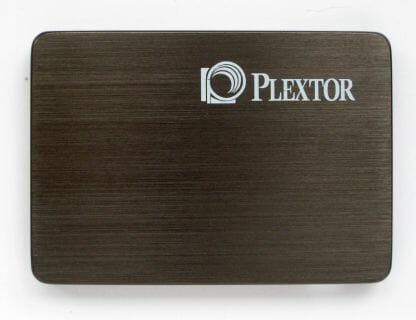
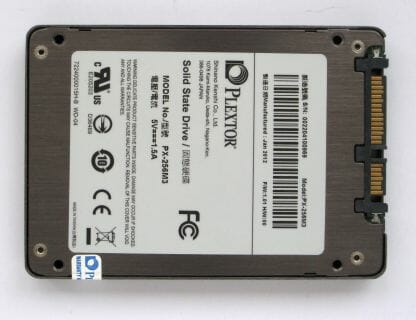
The case contains a PCB with a Marvell 88SS9174 controller, which is revision BKK2, and eight memory chips labeled TH58TEG7D2HBA4C. These are 24nm NAND MLC chips with Toggle Mode interface. Considering that this is a 256GB model, each chip contains four 64-gigabit semiconductor dies, so the eight-channel controller can use 4-way interleaving on each channel.
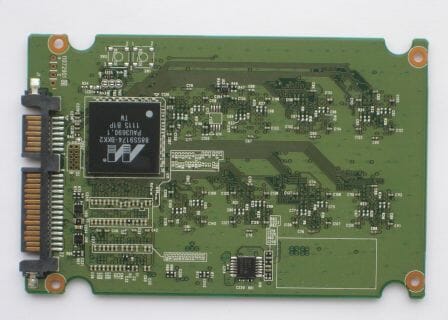
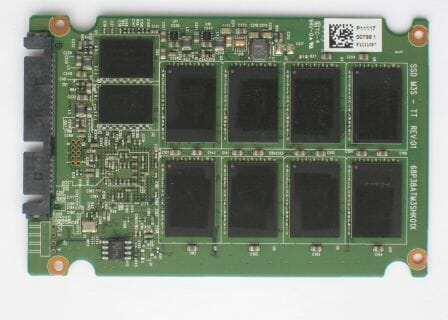
It must be noted that Plextor was one of the first manufacturers to start using 24nm flash from Toshiba. Such memory has by now become a trendy choice for SandForce-based SSDs but the Plextor M3 series was released a year ago when 24nm Toshiba flash was new.
Besides the controller and flash memory chips, Marvell-based SSDs feature an SDRAM buffer. The 256GB Plextor M3 employs two DDR3-1333 chips Nanya NT5CB128M16BP-CG which combine into a 512MB cache. Lower-capacity M3 series SSDs have a proportionally smaller cache.
Plextor M3 Pro 256GB
We must confess that the real reason for the M3 Pro series is a mystery to us. It was rolled out only two months after the M3 and didn’t differ from the latter. Of course, the manufacturer claimed higher performance, but not through any hardware improvements. Firmware optimizations were supposed to make the Pro version faster.
From the hardware aspect, the M3 Pro series can only boast a 7mm case which fits into ultraportable notebooks. The case design is the same as in the M3 series, just slimmer and without any anodizing.
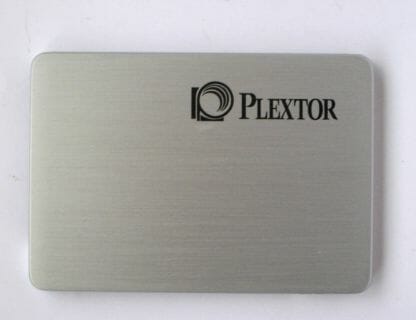
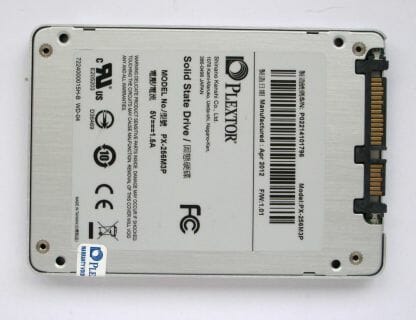
The PCB is the same, too. It even has the marking of the simpler series. There are almost no differences in terms of components, either, except that the Pro series features the newer and more popular revision BLD2 of the Marvell 88SS9174 controller. The rest of the components, including the SDRAM buffer and flash memory, are identical to those of the ordinary Plextor M3, but for marketing reasons the M3 Pro model range is different and does not include a 64GB model.
Notwithstanding the internal similarities, we do not know if it is possible to transform an ordinary M3 into an M3 Pro by rewriting firmware. This operation may be impossible due to limitations imposed by the manufacturer or to the difference in the controller revisions.
Plextor M5S 256GB
M3 and M3 Pro series SSDs feature good specs even by today’s standards but the use of Toggle Mode flash memory from Toshiba prevented Plextor from competing with more affordable SSDs. That’s why the company introduced the M5S series which can be viewed as a cheaper variant of the M3 with simpler synchronous flash memory with ONFI interface.
The warranty period for the M5S series is limited to 3 years whereas the previous SSDs from Plextor used to come with a 5-year warranty. An adapter for installing the drive into a 3.5-inch bay is removed from the accessories to make the M5S series cheaper.
But the appearance of the M5S is the same as of its predecessor M3. It has a typical case with a height of 9.5 millimeters.
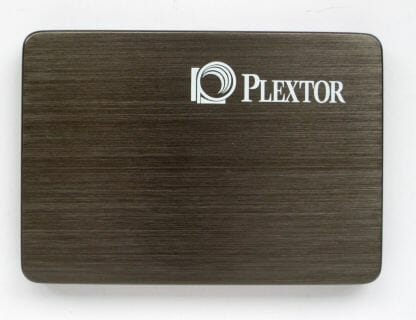
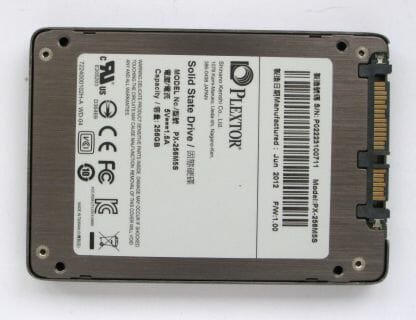
The case is designed in a simpler way inside, though. In M3 and M3 Pro SSDs each chip on the PCB had contact with the aluminum case via a thermal pad, but this thermal interface only remains on the main controller in the M5S.
The PCB is different. Although based on the same Marvell 88SS9174 controller revision BLD2, which works together with a DDR3-1333 SDRAM buffer built out of two 256MB Nanya chips, the flash memory is Micron 29F128G08CFAAB. This is NAND flash memory with ONFI interface which is manufactured on 25nm tech process. Such chips could be found, for example, in the Crucial m4, another popular Marvell-based SSD. The 256GB Plextor M5S contains 16 memory chips, each of which contains two 64-gigabit semiconductor dies. Therefore, the controller can use 4-way interleaving, just like in the M3 and M3 Pro. By the way, considering the use of flash chips with two dies each, there can be no 512GB model in the M5S series.
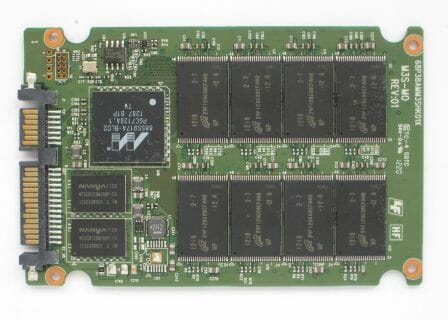
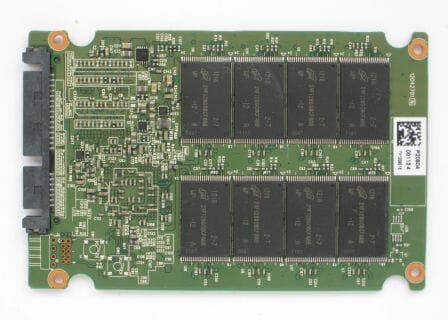
The manufacturer claims that the change of the memory type doesn’t affect performance. The M5S is promised to be in between the M3 and the M3 Pro in terms of speed. Moreover, these more affordable SSDs undergo the same procedure of 20-hour presale testing at a high temperature as the other SSDs from Plextor. On the other hand, you should be aware that the M5S series has a shorter service life theoretically. Its 25nm flash memory from Micron is rated for 3000 rewrite cycles whereas the Toshiba memory in the M3 and M3 Pro SSDs is expected to last through 5000 rewrite cycles.
Plextor M5 Pro 256GB
So, the M3 and M3 Pro series were followed by the M5S model which in fact delivered the same level of performance at a lower price, thus devaluating both older series. The M3 and M3 Pro seem more reliable, of course, which is also indicated by their longer warranty, yet this is not a strong argument for most consumers. That’s why Plextor needed another product that would be faster than any previous SSD. They have it now. It is the M5 Pro model featuring a completely new hardware platform based on Marvell’s newest controller 88SS9187.
The M5 Pro doesn’t betray any sign of its progressive hardware in its appearance. Plextor seems to see no need to change the time-tested SSD case design, so the M5 Pro looks exactly like the M3 Pro. Its brushed aluminum case has a height of 7 millimeters, making it suitable for ultrathin notebooks. The manufacturer’s logo is painted in gray on the face panel of the case. The sticker on the other side offers some service information including part and serial numbers.

The PCB is of course the most intriguing part of the M5 Pro, revealing a number of components we’ve never seen before: a new controller and 19nm flash memory. Oddly enough, the PCB is not only marked as M3S but is identical to the PCB employed for M3 and M3 Pro series. It means the new components are pin-compatible with their previous modifications, so the manufacturer can use the older PCB wiring.
There’s no mistake, though. The PCB indeed carries the highly promising Marvell 88SS9187 chip which is touted by its developer as the first controller for consumer-class SSDs capable of delivering a sequential write speed of up to 500 MB/s. That’s the appeal of the Plextor M5 Pro: with such hardware, it may turn out to be the fastest SSD with SATA 6 Gbit/s interface.
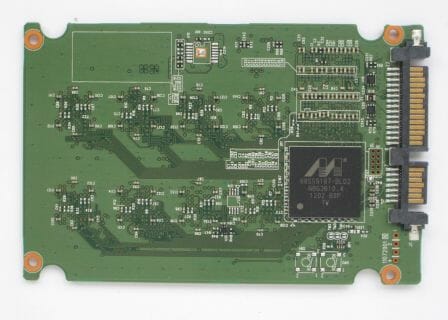
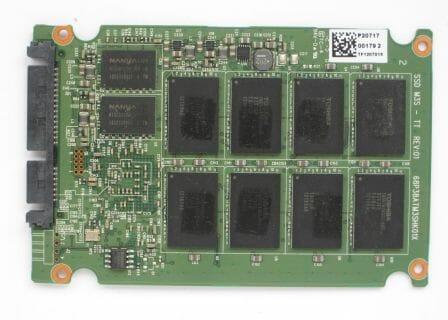
The flash memory employed by the M5 Pro is interesting, too. These are eight Toshiba TH58TEG8D2JBA8C chips which feature MLC NAND devices manufactured on the most progressive 19nm technology. Each chip contains four semiconductor dies with a conventional capacity of 64 gigabits. So, just like in the previous products, the M5 Pro’s controller can benefit from 4-way interleave on each channel. The key advantage of Toshiba’s 19nm chips is that they help make the end product cheaper but they do not offer any other benefits. Its Toggle Mode interface has the same bandwidth and its service life, according to the manufacturer, is no different from that of 24nm flash.
Besides the Marvell 88SS9187 controller and 19-nm Toggle Mode MLC NAND flash, the Plextor M5 Pro has a SDRAM buffer. The buffer is the standard size for Plextor SSDs: two 256MB DDR3-1333 SDRAM chips from Nanya.
Being a premium-class product, the Plextor M5 Pro boasts a 5-year warranty and comes with a complete set of accessories including an adapter for installing it into a 3.5-inch bay. Although targeted at enthusiasts, the M5 Pro has some properties intended for corporate users such as AES encryption with a 256-bit key. Data integrity is ensured by means of 128-bit ECC which is supported by the new Marvell controller.
Specifications
We’re going to cover the entire SSD line-up offered by Plextor. The following table provides additional information about components and technologies featured by different Plextor SSDs so that you could have an overall picture of the changes they have gone through over the last year.
As you can see, Plextor sticks to the Marvell+Toshiba formula, updating flash memory and controllers as soon as new versions become available. The M5S is the only exception, representing Plextor’s desire to release a more affordable product.
It is the lucky choice of platform that makes Plextor SSDs so successful, especially as there are currently no alternatives from other brands that would copy Plextor’s SSD designs. Besides choosing component suppliers properly, Plextor takes care to polish off firmware. Plextor SSDs have never been criticized for critical firmware bugs.
Moreover, the presale thermal chamber testing that each Plextor SSD undergoes helps cull out problematic samples before they even reach retail stores. The average failure rate of Plextor SSDs is no higher than 0.6%, which is one of the best results in the whole industry.
Plextor Software
Besides well-optimized and bug-free firmware, Plextor programmers offer an exclusive service utility called PlexTool. Its functionality is limited to reporting basic information about the SSD, though.
The FW UPDATE and SECURE FORMAT tabs are hardly useful. When you try to update firmware, you just get redirected to the Plextor website whereas the Secure Format procedure can only be performed for external drives connected via USB.
Testbed Configuration
For our today’s SSD test session we put together a system on an Intel H67 based mainboard. This chipset provides support for two SATA 6 Gbit/s ports, which we use to connect the tested SSDs.
Four different SSDs from Plextor is already a pretty interesting review topic. However, since this is the first time we introduce to you the new P5S and M5 pro drives, which we haven’t reviewed before, we decided to increase the number of testing participants for a more in-depth performance analysis. Plextor SSDs will compete against products based on SandForce controller (Intel SSD 520 and Corsair Force GS), new Corsair SSDs on LAMD LM87800 controller (Neutron GTX and Neutron), our irreplaceable OCZ Vertex 4 on Indilinx Everest 2 controller, very impressive proprietary Samsung SSD 830, and Crucial m4 representing the Marvell platform, just like the Plextor solid state drives. Since today we are discussing high-performance and not entry-level products, we chose only SSDs with synchronous flash-memory for our comparison. Corsair Neutron, Crucial m4, Intel SSD 520 and OCZ Vertex 4 use 25 nm memory from IMFT consortium with ONFI-interface. While, Corsair Force GS, Corsair Neutron GTX and Samsung 830 are the drives with Toggle Mode MLC NAND manufactured using 2x-nm process.
Overall our testbed was configured as follows:
- Intel Core i5-2400 (Sandy Bridge, 4 cores, 3.1 GHz, EIST and Turbo Boost turned off);
- Foxconn H67S mainboard (BIOS A41F1P03);
- 2 x 2 GB DDR3-1333 SDRAM DIMM 9-9-9-24-1T;
- Crucial m4 256 GB system disk (CT256M4SSD2);
- Tested SSDs:
- Corsair Force GS Series 240 GB (CSSD-F240GBGS-BK, firmware version 5.03);
- Corsair Neutron GTX 240 GB (CSSD-N240GBGTX-BK, firmware version 2.06);
- Corsair Neutron 240 GB (CSSD-N240GB3-BK, firmware version 2.06);
- Crucial m4 256 GB (CT256M4SSD2, firmware version 010G);
- Intel SSD 520 240 GB (SSDSC2CW240A3K5, firmware version 400i);
- OCZ Vertex 4 256 GB (VTX4-25SAT3-256G, firmware version 1.5);
- Plextor M3 256 GB (PX-256M3S, firmware version 1.05);
- Plextor M3 Pro 256 GB (PX-256M3P, firmware version 1.04);
- Plextor M5S 256 GB (PX-256M5S, firmware version 1.00);
- Plextor M5 Pro 256 GB (PX-256M5P, firmware version 1.01);
- Samsung SSD 830 256 GB (MZ-7PC256D, firmware version CXM03B1Q).
- Microsoft Windows 7 SP1 Ultimate x64
- Drivers:
- Intel Chipset Driver 9.3.0.1019;
- Intel Graphics Media Accelerator Driver 15.22.54.2622;
- Intel Rapid Storage Technology 11.2.0.1006.
Performance
Random and Sequential Read/Write
We use CrystalDiskMark 3.0.1 benchmark to test the random- and sequential read and write speed. This benchmark is convenient to work with as it can measure the speed of an SSD with both incompressible random and fully compressible recurring data. This feature is important for testing SSDs based on SF-2281/2282 controller, which tries to compress the data before writing it into the flash-memory. So, there are two numbers in the diagrams below that reflect the maximum and minimum SSD speed. The real-life performance of an SSD is going to be in-between those two numbers depending on how effective the controller data compression is.
Note that the performance tests in this section refer to SSDs in their “Fresh Out-of-Box” state (FOB). No degradation could have taken place yet.
The Plextor SSDs are all birds of a feather. They are very fast, including the older M3 and M3 Pro series, and show the same behavior in different benchmarks. We can only single out the M5 Pro which features Marvell’s new controller. It stands out among its cousins as well as competitors and offers a new level of performance indeed. It is among the fastest SSDs in reading and writing with a long request queue, so we have no doubts it is going to make any computer highly responsive and fast in real-life applications.
The M5S series is good, too. Although based on the same hardware components as the Crucial m4, Plextor’s affordable drive is substantially faster. Just as we might assume according to the specs, the M5S is indeed close in performance to Plextor’s older SSD series, which means that it is a strong mainstream product today.
Degradation and Steady-State Performance
Unfortunately, SSDs are not always as fast as in their “fresh” state. In most cases their performance goes down after some time and in real life we deal with completely different write speeds than what we see on the diagrams in the previous chapter of our review. The reason for this phenomenon is the following: as the SSD runs out of free pages in the flash memory, its controller has to clear memory page blocks before saving data into them, which causes substantial delays. Although, modern SSD controllers can alleviate the performance drop by erasing unused flash memory pages ahead of time, when idle. They use two techniques for that: idle-time garbage collection and TRIM.
Of course, users are more interested in the consistent performance of their SSDs over a long period of time rather than the peak speed they are going to see only during the initial short-term usage period, while the drive is still “fresh”. The SSD makers, however, declare the speed characteristics of “fresh” SSDs for marketing reasons. That’s why we decided to test the performance hit that occurs when a “fresh” SSD becomes a “steady” one.
To get a complete picture of SSD performance degradation we ran special tests based on the SNIA SSSI TWG PTS (Solid State Storage Performance Test Specification) methodology. The main idea of this approach is to measure write speed consecutively in four different cases. First we measure the “fresh” SSD speed. Then we measure the speed after the SSD has been fully filled with data twice. The third test occurs after a 30-minute break during which the controller can partially restore performance by running the idle-time garbage collection. And finally, we measure the speed after issuing a TRIM command.
We ran the tests in synthetic IOMeter 1.1.0 RC1 benchmark, where we measured random write speed when working with 4 KB data blocks aligned to flash memory pages at 32 requests queue depth. The test data were pseudo-random. The following diagram shows the history of the relative speed changes, where 100% refers to the SSD performance in “fresh-out-of-box” state.
Plextor SSDs feature True Speed technology which helps ensure high performance even without the TRIM command. The technology refers to an aggressive and intellectual garbage collection technique which is actually employed by many other SSDs with Marvell controllers as well as Corsair’s LAMD-based solutions. And it works well. The Plextor SSDs do their background garbage collection perfectly. Their write performance can be restored to 60-80% of the out-of-box speed even when the SSD is filled with data to the brim. That’s very good.
It is no wonder then that Plextor’s TRIM-triggered garbage collection works ideally, restoring each drive to its original write performance. It means that Plextor SSDs are going to always deliver consistent and predictable performance in TRIM-supporting environments, e.g. in recent versions of Microsoft OSes.
Since the characteristics of most SSDs do change once they transition from fresh out-of-the-box state into steady state, we measure their performance once again using CrystalDiskMark 3.0.1 benchmark. The diagrams below show the obtained results. We use random data writing and measure only performance during writes, because read speed remains constant.
As the SandForce platform is losing its ground, the diagrams showing steady-state write performance of SSDs become more like the diagrams that show their out-of-box write performance. Performance degradation only plagues the SF-2281 controller while the others handle the TRIM command perfectly and keep their performance high throughout their entire service life.
So, we can’t add anything new about the Marvell-based Plextor SSDs here. Yes, they are not very fast at writing, but typical SSD usage scenarios are all about reading. Moreover, desktop computers do not produce a long disk request queue.
Futuremark PCMark 7
The popular PCMark 7 contains an individual disk subsystem benchmark. It is not a synthetic test, but is based on real-life applications. This benchmark reproduces typical disk usage scenarios and measures how fast they are completed in popular applications. Moreover, the disk access commands are not executed as a steady uninterrupted flow, but in a more realistic manner – with certain pauses caused by the need to process the data. The benchmark generates an overall disk subsystem performance rating as well as speed readings in MB/s in individual usage scenarios. Note that the absolute speed in these scenarios is not too high because of the above mentioned pauses between individual input/output operations. In other words, PCMark 7 shows you the speed of the disk subsystem from the application’s point of view. Numbers like that show us not only the pure performance of an SSD, but mostly how big of a performance gain a certain SSD can guarantee in real life.
We ran PCMark 7 on “steady” SSDs, which is what they are going to be in actual computer systems most of the time. Their performance in this case is affected not only by their controller or flash memory speed but also by the efficiency of their internal algorithms that fight performance degradation.
Notwithstanding its predilection towards the SandForce platform, this benchmark puts the Plextor M5 Pro on the very top or the list. It means the new flagship SSD from Plextor is really very fast.
The rest of the Plextors go close to each other, following a pair of SF-2281 based drives. Thus, according to PCMark 7, they are good for real-life applications, beating such popular solutions as Corsair Neutron GTX, OCZ Vertex 4 and Samsung SSD 830. They are somewhat slower than the SandForce-based drives, though. Compared to the Crucial m4, which is similar to it in price and hardware components, the M5S delivers much higher performance.
Now let’s check out the individual tests to get a more detailed picture of what our SSDs are capable of under various types of operational load.
Take note that the Plextor SSDs are close to each other in most of the diagrams. Using similar hardware, they behave in a similar way. And this behavior seems to be optimal from a desktop user’s point of view. The Plextor SSDs take top places in the crucial Starting Applications scenario and are only second to the SF-2281 based solutions in the Gaming scenario. Of course, it is the new M5 Pro that is the fastest in the Plextor team, yet the M5S model is good, too. It is somewhat slower than its predecessors, but we shouldn’t forget that it is an affordable drive with common 25nm ONFI flash.
Intel NAS Performance Toolkit
Intel NASPT is another disk sub-system test that uses real-life usage scenarios. Like PCMark 7, Intel NASPT reproduces predefined disk activity traces and measures how fast they are executed. However, the default traces are designed for network attached storage devices rather than for SSDs. Therefore during our test session we replace them with the specially developed SSD Benchmarking Suite which offers more relevant usage scenarios such as compressing and decompressing files, compiling large projects, copying files and folders, loading 3D game levels, installing software, batch-processing photos, searching a digital library for data, mass-launching applications, and transcoding video.
Like PCMark 7, this benchmark gives us a true-to-life illustration of disk subsystem performance. Here the SSDs are again tested in their “steady” state.
Intel’s NASPT benchmark is more adequate, in our opinion, when it comes to real-life applications. And it shows that Plextor’s new M5 Pro raises the performance bar to a higher level. Marvell’s much-touted 88SS9187 controller seems to be capable of powering a new generation of SSDs with higher average performance than what is offered by the rest of SSD platforms available today.
The Plextor M5S looks good, too. It is in the top part of the diagram, higher than many products which are viewed as fast and progressive. For example, the M5S is obviously better than the Intel SSD 520 or the OCZ Vertex 4.
Besides the average benchmark score, we would also like to offer you the results of individual usage scenarios, which will show where Plextor SSDs can really shine. Note that the data-transfer rate is higher than the SATA III interface bandwidth in some subtests. That’s because INASPT is a high-level test that uses standard Windows functions to access the disk subsystem. As a result, the OS caching mechanisms also affect the results.
Of course, the Plextor M5 Pro can’t set records in every scenario, especially as it’s hard to compete with the Intel SSD 520 whose firmware is optimized for specific desktop operations. Anyway, there are quite a lot of situations where the newest Marvell-based SSD is ahead and all of them involve processing large files. But even if it doesn’t win a test, the Plextor M5 Pro consistently delivers high performance. It doesn’t have any slumps in performance in any scenario.
The Plextor M5S is average among the best. It doesn’t win any tests, yet it is 100% worth its price.
File Copying
We use AS SSD version 1.6.4237.30508 test to benchmark the speed of copying files within a single partition the size of the whole SSD. The SSDs are tested in their steady state.
Reading and writing in parallel proves to be more difficult for the newer Plextor products. The company doesn’t seem to optimize its firmware for such loads. The result is that the M3 Pro and M3S series are ahead of the newer Plextor drives, yet the Plextor M5 Pro and M5S aren’t hopeless, either. They are just average in this test.
Conclusion
We’ve long come to regard Plextor as one of the best makers of consumer-class SSDs. The company’s products combine high performance with reliability and come with a long warranty. They are not as affordable as we might wish, yet low price and high quality are hard to come by in one device.
Launching their new M5 Pro and M5S series, Plextor tried to expand their target audience a little. Compared to the previous SSDs from the M3 and M3 Pro series, the new series stand out more, both in performance and in market positioning. While the Plextor M5 Pro is a premium-class product claiming to be the fastest SATA 6 Gbit/s solution available, the M5S is meant for the mainstream sector. And our tests suggest that both have a good chance of reaching their goals.
To be more specific, the Plextor M5S is as fast as the M3 but at a more affordable price. It means that it is fast enough even according to today’s standards and can make a good choice for mainstream systems. Considering that it’s based on a time-tested platform with Marvell 88SS9174 controller, then M5S series should be on top of your list, if your budget is limited.
The Plextor M5 Pro is, in its turn, worthy of the champion title. This is the first SSD to bring the platform based on the new Marvell 88SS9187 controller to the market, which turns out a great success. Our tests showed that this product was one of the fastest consumer-class SSDs available today. It will surely be appreciated by enthusiasts who do not mind its high price.
That’s why we are proud to award our Editor’s Choice title to the Plextor M5 Pro SSD series. So far this is the fastest SSD with SATA 6 Gbit/s interface in our lab.
Some time ago we started to fill in a summary table with test results of various SSDs. It contains basic hardware information about the tested SSDs and allows to quickly determine the general position of a particular model among its competitors in terms of relative performance.